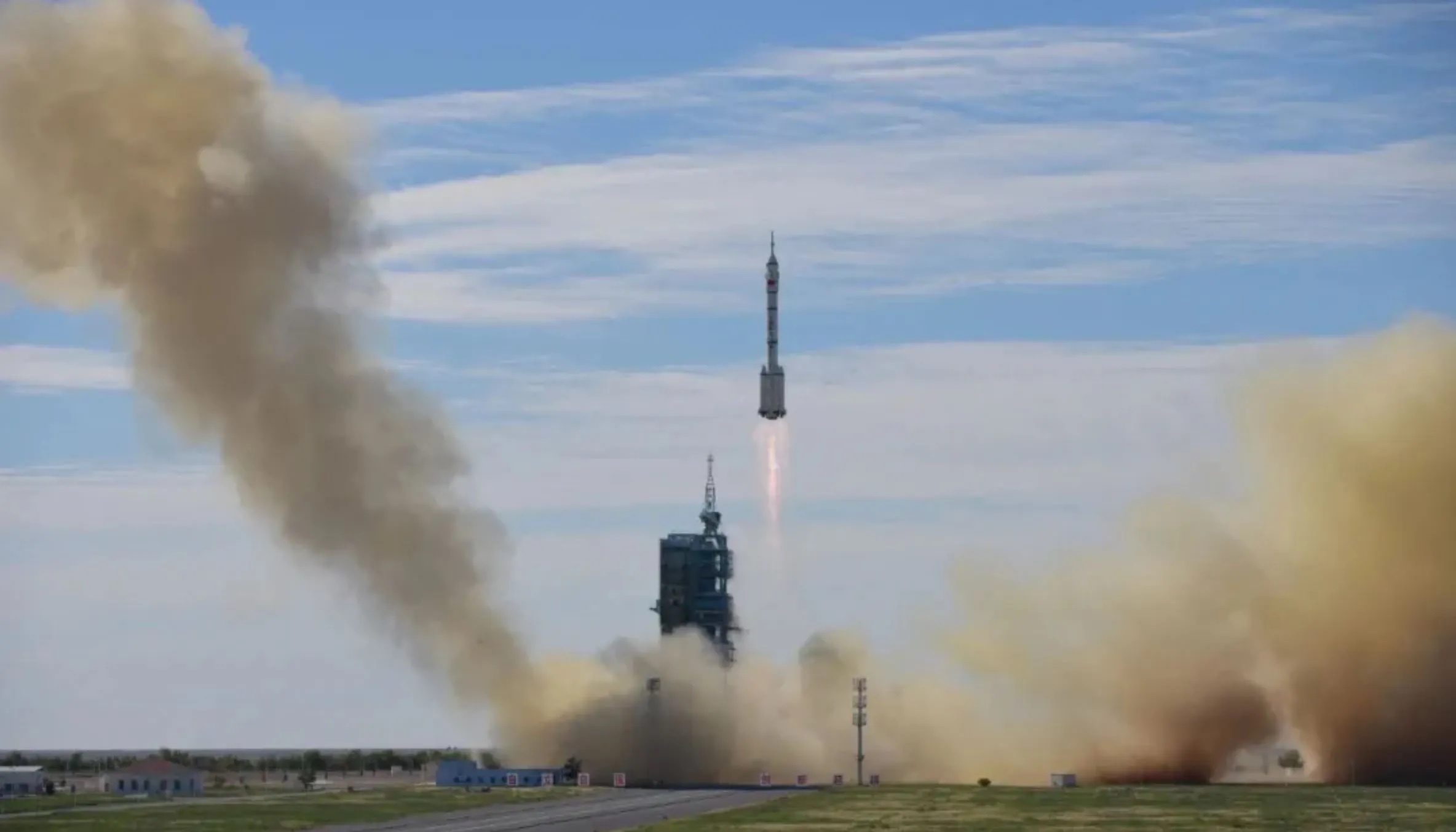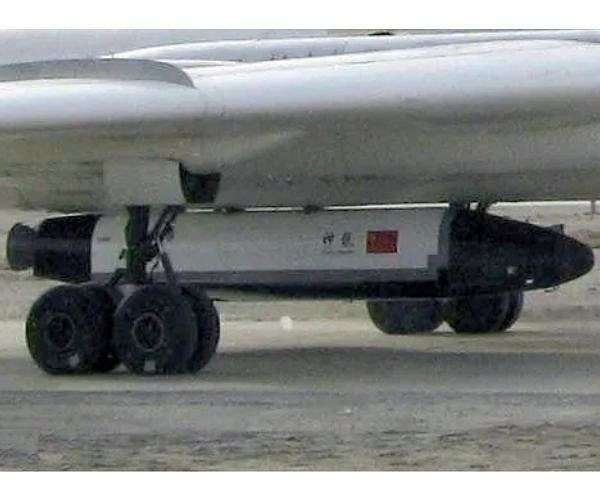16.12.2023
China successfully launched a reusable test spacecraft by a Long March-2F carrier rocket from the Jiuquan Satellite Launch Center in northwest China on Thursday.
The reusable test spacecraft will operate in orbit for some time before returning to the scheduled landing site in China.
During the in-orbit operation, the spacecraft will conduct verifications for reusable technologies and space science experiments to provide technical support for the peaceful use of space.
Quelle: Xinhua
+++
China launches mystery reusable spaceplane for third time

HELSINKI — China launched its experimental reusable spacecraft for the third time Thursday while maintaining strict secrecy around the mission.
A Long March 2F rocket lifted off from the Jiuquan Satellite Launch Center in the Gobi Desert Dec. 14, sending a “reusable test spacecraft” into low Earth orbit, Chinese language state media Xinhua reported.
Airspace closure notices suggest a launch time of around 10:00 a.m. Eastern (1500 UTC), but the report, published within an hour of expected launch, did not provide a time. The terse report stated that the test spacecraft will “operate in orbit for a period of time” before returning to its intended landing site in China.
“During this period, reusable technology verification and space science experiments will be carried out as planned to provide technical support for the peaceful use of space,” the report read, according to a machine translation.
The gap between the spacecraft’s first and second missions—launching in 2020 and 2022 respectively—was one year and 11 months. The third launch comes just over seven months after the spacecraft returned to Earth after its 276-day-long second mission.
The shortened time between missions suggests the spacecraft’s developer, the China Aerospace Science and Technology Corporation (CASC), has made progress in aspects relating to reusability of the spacecraft.
U.S. Space Force space domain awareness later cataloged the spacecraft in a 333 by 348-kilometer-altitude orbit inclined by 50 degrees. Space launch activity observer Jonathan McDowell estimated launch occurred at around 1412 UTC, based on the orbital data.
China has revealed no details of its experimental reusable spacecraft project. No images of any of the launches have been published. The suspected spaceplane is launched vertically on a Long March 2F, a rocket used to launch China’s Shenzhou crewed missions.
The launcher has a payload capacity of just over eight metric tons to low Earth orbit. This suggests that the spacecraft could be somewhat similar in size and function to U.S. Air Force’s X-37B spaceplane.
This notion is reinforced by apparent images of the payload fairing wreckage recovered from the second launch and posted on the Sina Weibo social media site. The images give possible clues as to the dimensions and shape of the spacecraft.
The previous missions included deploying satellites into orbit and may have involved scientific and other experiments. The spacecraft also performed numerous small and much larger orbital maneuvers during its second flight. The third flight will likely have a different scope and seek to further test the spacecraft’s capabilities.
The reusable spacecraft may be the orbital segment which will operate in combination with a reusable suborbital first stage. A reusable suborbital spacecraft was tested for the first time in 2021. A second mission launched in August 2022. The suborbital craft uses a vertical takeoff and a horizontal landing.
CASC has previously stated plans to develop a fully reusable, two-stage-to-orbit (TSTO) space transportation system. CASC’s spaceplane project last year acquired national level funding from the Natural Science Foundation of China.
Sino-U.S. space competition
The U.S. started launching its reusable X-37B in 2010. It is set to launch on its seventh mission on a Falcon Heavy rocket later this month. The launch has been hit with delays in recent days. The mission will test new orbital regimes, experiment with space domain awareness technologies, and investigate radiation effects on materials provided by NASA.
The Chinese and Boeing’s X-37B projects may, despite opacity surrounding respective intentions and capabilities, be illustrative of the broader space situation.
“Based on what little information we have, I think the Shenlong [Chinese spaceplane] and the X-37B are likely doing many of the same missions,” Brian Weeden, Director of Program Planning at the Secure World Foundation, told SpaceNews. “That is, primarily being used for experimenting and testing new technologies, sensors, and perhaps even operational practices.
“I think both programs are reflective of the current relationship between the US and China,” says Weeden. “Each sees the other’s secretive spaceplane program as a potential threat and destabilizing weapon, while insisting that their own program is important but benign.”
“That to me signals that we are in the midst of a security dilemma in space, where actions taken by both sides to reinforce their own security end up adding to the instability in the overall relationship.”
| Mission | Launch Date | Landing Date | Duration | Time Since Previous Mission | Launch Site | Landing Site |
|---|---|---|---|---|---|---|
| Mission 1 | September 4, 2020 | September 6, 2020 | 2 days | N/A | Jiuquan spaceport | Lop Nur air base |
| Mission 2 | August 4, 2022 | May 8, 2023 | ~276 days | 1 year, 11 months | Jiuquan spaceport | Lop Nur air base |
| Mission 3 | December 14, 2023 | N/A | N/A | 7 months, 6 days | Jiuquan spaceport | N/A |
The development of reusable spacecraft technology is part of China’s broader strategy to become a major spacefaring nation. Chinese President Xi Jinping has set a national goal for China to become a powerful aerospace country. Xi also noted the space industry to be a critical element of overall national strategy.
Further Chinese efforts
CASIC, a sister giant defense and space contractor, is working on its own TSTO spaceplane, named Tengyun.
Chinese commercial firm Space Transportation raised more than $46.3 million for its hypersonic spaceplane plans in 2021. The firm stated last year it was aiming for space tourism test flights in 2025.
China has been seeking to boost its flexibility and range of access to space in recent years. In 2014 the government allowed private capital into the space sector to help foster a commercial space sector.
Commercial launch firms now operate a number of solid and liquid launch vehicles. Hop tests are now underway at Jiuquan as firms attempt to develop reusable rocket capabilities.
CASC is meanwhile developing a super heavy-lift reusable launch vehicle named Long March 9. The Long March 10, intended to launch crew and take astronauts to the moon, will have a potentially reusable first stage.
Quelle: SN
+++
China's Shenlong space plane embarks on another secretive mission in space

2017 photograph displaying the Shenlong space vehicle mounted under a Xian H-6 bomber, as circulated on Chinese online platforms. their space missions, signifying the nation's expanding footprint in the global space exploration arena.
In a significant advancement for China's space technology, the successful launch of a Long March 2F carrier rocket from the Jiuquan Satellite Launch Center in Northwest China's vast Gobi Desert has marked a new chapter. This event is particularly noteworthy as it is believed to have placed the Shenlong (Divine Dragon) space plane into orbit.
The Shenlong project, enveloped in mystery and thought to be a product of collaboration between the People's Liberation Army and the China Aerospace Science and Technology Corporation (CASC), signifies China's robust stride in the arena of reusable space plane technology, paralleling efforts like the United States' X-37B. Yet, the specifics of Shenlong's design, capabilities, and mission goals remain largely under wraps, with only limited verified details available to the public.
This latest mission, as detailed in a Thursday night press release, sees the Shenlong spacecraft embarking on an orbit-bound journey for a pre-set duration before its planned return to a designated landing site within China. The spacecraft's primary role during this mission is to perform space science experiments and validate technologies essential for reusable spacecraft, thereby contributing to the peaceful exploration and utilization of space. Intriguingly, the Chinese authorities have maintained a veil of secrecy over the mission, opting not to release imagery of the rocket launch or activities within the ground control center.
This launch signifies the third occasion where China has publicly acknowledged a mission involving a reusable experimental spacecraft. Reflecting on the country's previous endeavors, the first orbital test conducted in September 2020 had the craft in space for almost two days. The subsequent mission, initiated in August 2022, showcased an extended orbital period where the spacecraft remained in space for 276 days before landing in May 2023. The successful completion of these missions underscores substantial progress in China's pursuit of reusable spacecraft technology, an effort aimed at fostering more affordable and efficient space travel.
Each of these earlier missions, including the recent one, relied on the Long March 2F rocket, launched from the Jiuquan center. This rocket type, predominantly employed for sending China's Shenzhou crewed spaceships into orbit, has achieved its 22nd launch, boasting a capability to transport over 8 metric tons to low Earth orbit.
The development and operationalization of reusable spacecraft is a domain where only a few global players, specifically China and the United States, have demonstrated capability. Originating from the U.S. space shuttle program of the 1970s, the concept of reusable spacecraft has witnessed a resurgence in recent years. This renewed interest is particularly evident in the emergence of smaller, cost-effective robotic spaceplanes like the Boeing X-37B.
The Shenlong space plane, with its anticipated reusable nature and versatile utility for missions such as reconnaissance, satellite deployment, or experimental technology testing, aligns with these global trends in space exploration. Although the exact functionalities and operational objectives of Shenlong are not as transparent as those of the U.S. X-37B, its development is a clear indicator of China's escalating expertise and ambition in space technology.
China's progress in the field of reusable spacecraft, exemplified by the Shenlong space plane, not only underscores the nation's evolving role in the international space community but also reflects a broader shift towards more sustainable and versatile approaches in space exploration and utilization. As the world watches, the Shenlong continues to be a focal point of speculation and interest, representing both the achievements and the aspirations of China's space program.
Quelle: SD

